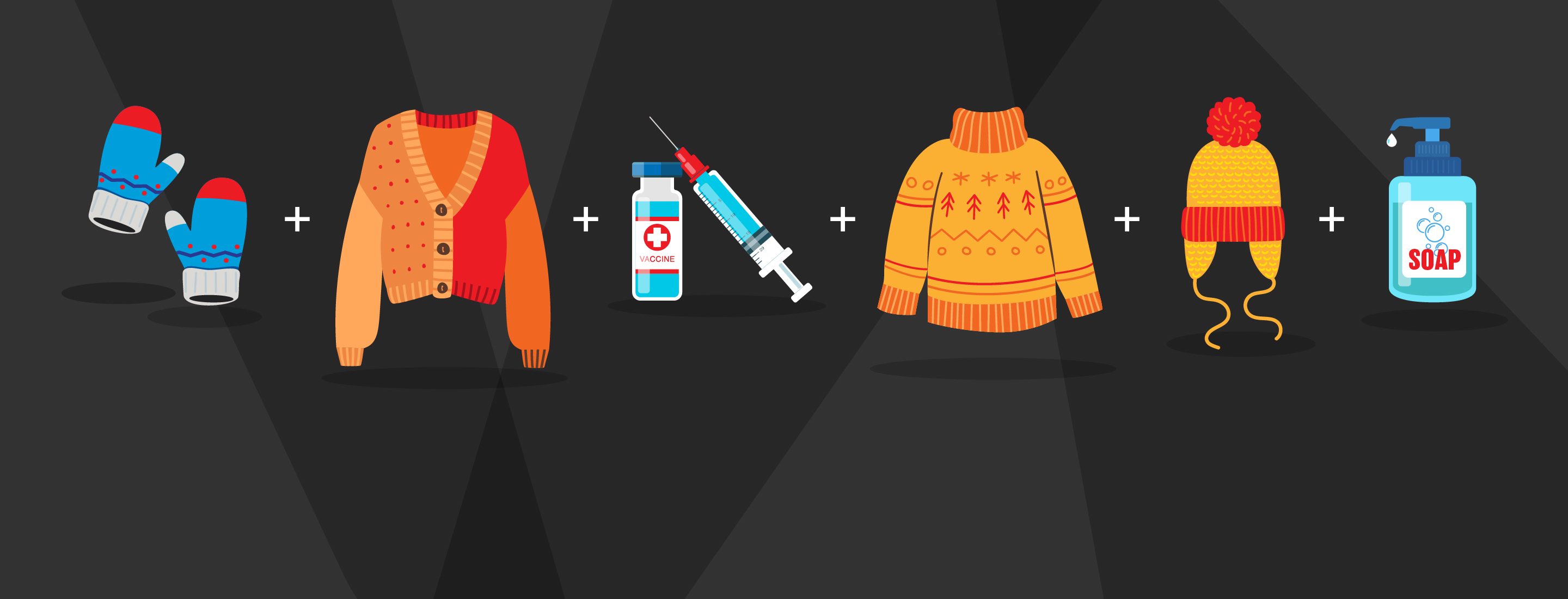Layer Up to Stay Protected From Illness
This fall, stack your defenses by combining multiple layers of protection to help prevent serious illness caused by the flu (influenza), and other respiratory illnesses such as COVID-19 and Respiratory Syncytial Virus (RSV).
Prevent the flu, RSV and COVID-19
Get Vaccinated | Stay Home When Sick | Wash Your Hands

We are all at risk of getting colds, the flu (influenza), and other respiratory illnesses such as COVID-19 and Respiratory Syncytial Virus (RSV). Those at a higher risk of needing to be hospitalized include:
- Older adults
- Young children
- People with weakened immune systems
- People with lung or heart conditions
- Pregnant people
Everyone has a role to play to reduce the spread of these illnesses, and staying healthy allows you to stay connected with your loved ones. Learn more about how you can protect yourself, your family and community this season.
Layers of protection: Tips to keep yourself and others healthy
Prevent the spread of the flu, COVID-19 and RSV. Here’s how you can “layer up”:
- Stay current and up to date with a COVID-19 and flu vaccine (and RSV vaccine if you are eligible)
- Stay at home when you are sick
- Wash your hands often with soap and water
- If soap and water are unavailable, use hand sanitizer with at least 70% alcohol
- Cover your mouth and nose with a tissue when you cough or sneeze and throw the tissue out immediately. Wash hands afterwards. Cough in your upper sleeve if you don’t have a tissue
- Clean and disinfect high-touch surfaces regularly
- Wear a well-fitted mask in crowded, indoor settings for added protection
What to do if you have symptoms?
If you have symptoms:
- Stay home until you have no fever (without the use of fever-reducing medications such as ibuprofen or acetaminophen) and your symptoms have been improving for 24 hours (48 hours for vomiting/diarrhea)
- If you cannot stay home: wear a tight-fitting, well-constructed mask
- It is recommended to continue to wear a mask in public for 10 days after symptoms start
- Avoid visiting those at higher risk of severe illness, including people living in long-term care, retirement homes or hospitals
- Most respiratory illnesses can be treated at home. Antiviral treatment for COVID-19 and influenza is available for those at higher risk of severe illness
For additional information from a health care professional, visit Health811 online or call 811 24 hours a day, 7 days a week.
Where can I get vaccinated?
Influenza (Flu)
An annual flu shot is your best defense against getting sick with the flu. It is recommended for anyone six months of age and older.
COVID-19
This fall, the annual COVID-19 vaccine will be available to everyone aged six months and older to protect against current COVID-19 variants.
RSV
- Older adults (over 60 years of age): RSV vaccine is available for high-risk individuals 60 to 74 years of age and all individuals aged 75 and older
- Infant/high risk children: There are two safe and effective ways to prevent severe RSV infection in infants:
- Protection with monoclonal antibodies (Beyfortus) given after birth (this is the more effective option), OR
- RSV vaccine is given during pregnancy (at 32 to 36 weeks gestational age)
- For more details, see york.ca/RSV
Here’s where you can get vaccinated
| Vaccine Providers/ Support | Influenza (Flu) Vaccines | COVID-19 Vaccines | RSV Vaccines |
|---|---|---|---|
| Participating pharmacies* |
|
| Not available |
| Some doctor or nurse practitioner's offices* |
|
|
|
| Long Term Care & Retirement Facilities | Staff, residents | Staff, residents |
|
| Some walk-in medical clinics* |
|
|
|
| York Region Public Health Clinics |
|
| Older adults aged 75+ (limited appointments available) |
*Before visiting, check if they are offering vaccines and if an appointment is required.
Integrated Respiratory Dashboard
York Region Public Health updates the dashboard content weekly to present information on COVID-19, influenza (flu), and respiratory syncytial virus (RSV) disease activity and trends in York Region. The data includes information on disease severity, high-risk populations, and the general community.
Integrated Respiratory Dashboard
If you would like to view this dashboard in an alternative format for accessibility, please contact @email.
Frequently asked questions (FAQs)
Q. What's the difference between the flu, COVID-19 and RSV?
All three are respiratory illnesses, have very similar symptoms that overlap, and pose an increased risk in those with underlying health conditions or weakened immune systems.
The following outlines the differences as far as those who are the most susceptible to illness and severe disease:
- The flu (influenza) carries the biggest threat to infants and young children, older adults and pregnant people
- COVID-19 poses the biggest risk to those who are older
- RSV poses the biggest threat to infants and young children
Q. Why do people get sick more often with the flu, COVID-19 and RSV during the colder months?
Colder temperatures can reduce our body’s ability to fight off infections; plus, when we spend more time indoors, we can spread viruses to one another more easily.
Q. Who can get these vaccines?
Both COVID and flu vaccines are free for everyone six months of age and older who lives, works or attends school in Ontario. No OHIP card is required at our York Region Public Health clinics; however, an OHIP card may be requested by other vaccine providers. RSV vaccines are free for eligible groups.
Q. Can I get more than one vaccine at the same time?
Yes. You can get the flu vaccine at the same time as other vaccines, including the COVID-19 and RSV vaccine (if eligible), or at any time before or after. Talk to a health care provider or pharmacist to learn more.


